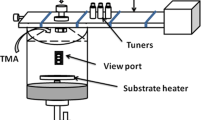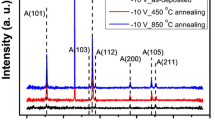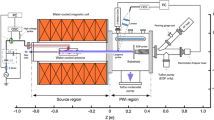Abstract
The expansion of an oxygen low-pressure microwave plasma was investigated in order to determine the optimal plasma parameters for the growth of functional oxide semiconductors. Langmuir probe measurements show that the electron density (n e ) increases with the injected power up to a saturation value of 3.0 × 109 cm−3 determined at 10 mTorr while electron temperature (T e ) remains constant at a value of 1.5 eV. When pressure is varied, n e shows a maximum value at a range from 12 to 20 mTorr while T e decreases monotonously with increasing pressure. In addition, both n e and T e decrease with the axial distance from the plasma source. These effects were discussed through the loss mechanisms in the remote plasma. For a pressure of 13 mTorr and at a substrate temperature of 500 °C, plasma enhanced oxidation of pure metallic Ti thin films lead to the formation of a pure TiO2 anatase phase compared to a mixed phase of TiO2 and TiO in the absence of plasma activation. For Mn thin films, the exposure to oxygen remote plasma led to the formation of MnO2 as opposed to obtaining Mn3O4 when oxidation is performed in the oxygen gas ambient. Remote plasma processing was thus found to provide selective pathways to control oxidation states, stoichiometry and phase composition of technologically attractive oxide thin films.








Similar content being viewed by others
References
Faber H, Hirschmann J, Klaumünzer M, Braunschweig B, Peukert W, Halik M (2012) Impact of oxygen plasma treatment on the device performance of zinc oxide nanoparticle-based thin-film transistors. ACS Appl Mater Interfaces 4:1693–1696
Iwasaki Y, Izumi A, Tsurumaki H, Namiki A, Oizumi H, Nishiyama I (2007) Oxidation and reduction of thin Ru films by gas plasma. Appl Surf Sci 253:8699–8704
Gudmundsson JT (2004) Recombination and detachment in oxygen discharges: the role of metastable oxygen molecules. J Phys D Appl Phys 37:2073–2081
Normand F, Granier A, Leprince P, Marec J, Shi MK, Clouet F (1995) Polymer treatment in the flowing afterglow of an oxygen microwave discharge: active species profile concentrations and kinetics of the functionalization. Plasma Chem Plasma Process 15:173–198
Canal C, Gaboriau F, Ricard A, Mozetic M, Cvelbar U, Drenik A (2007) Density of O-atoms in an afterglow reactor during treatment of wool. Plasma Chem Plasma Process 27:404–413
Yang L, Ge D, Zhao J, Ding Y, Kong X, Li Y (2012) Improved electrochromic performance of ordered macroporous tungsten oxide films for IR electrochromic device. Sol Energy Mater Sol Cells 100:251–257
Straumal BB, Protasova SG, Mazilkin AA, Schütz G, Goering E, Baretzky B, Straumal PB (2013) Ferromagnetism of zinc oxide nanograined films. JETP Lett 97:367–377
Peng YH, Huang GF, Huang WQ (2012) Visible-light absorption and photocatalytic activity of Cr-doped TiO2 nanocrystal films. Adv Powder Technol 23:8–12
Lee W, Shin S, Jung DR, Kim J, Nahm C, Moon T, Park B (2012) Investigation of electronic and optical properties in Al–Ga co-doped ZnO thin films. Curr Appl Phys 12:628–631
Xu S, Diao L (2008) Study of tungsten oxidation in O2/H2/N2 downstream plasma. J Vac Sci Technol A 26:360–364
He G, Fang Q, Liu M, Zhu LQ, Zhang LD (2004) The structural and interfacial properties of HfO2/Si by the plasma oxidation of sputtered metallic Hf thin films. J Cryst Growth 268:155–162
Busani T, Devine RAB (2009) Physical and optical properties of room temperature microwave plasma anodically grown TiO2. J Vac Sci Technol A 27:725–730
Leng YX, Chen JY, Yang P, Sun H, Huang N (2003) Structure and properties of passivating titanium oxide films fabricated by DC plasma oxidation. Surf Coat Technol 166:176–182
Jayasinghe RC, Perera AGU, Zhu H, Zhao Y (2012) Optical properties of nanostructured TiO2 thin films and their application as antireflection coatings on infrared detectors. Opt Lett 37:4302–4304
Liu X, Chen C, Zhao Y, Jia B (2013) A review on the synthesis of manganese oxide nanomaterials and their applications on lithium-ion batteries. J Nanomater. doi:10.1155/2013/736375
Han X, Zhang F, Meng Q, Sun J (2010) Preparation and characterization of highly activated MnO2 nanostructure. J Am Ceram Soc 93:1183–1186
Hannemann M, Hamann S, Burlacov I, Börner K, Spies HJ, Röpcke J (2013) Langmuir probe and optical diagnostics of active screen N2–H2 plasma nitriding processes with admixture of CH4. Surf Coat Technol 235:561–569
Tabbal M, Kahwagy S, Christidis T, Nsouli B, Zahraman K (2006) Pulsed laser deposition of nanostructured dichromium trioxide thin films. Thin Solid Films 515:1976–1984
Taylor KJ, Tynan GR (2005) Control of dissociation by varying oxygen pressure in noble gas admixtures for plasma processing. J Vac Sci Technol A 23:643–650
Ferreira CM, Moisan M (1988) The similarity laws for the maintenance field and the absorbed power per electron in low-pressure surface wave produced plasmas and their extension to HF plasmas in general. Phys Scr 38:382–399
O’Hanlon JF (2003) A user’s guide to vacuum technology, 3rd edn. Wiley, New York
Stoffels E, Stoffels WW, Vender D, Kando M, Kroesen GMW, de Hoog FJ (1995) Negative ions in a radio-frequency oxygen plasma. Phys Rev E 51:2425–2435
Chung TH, Kang HR, Bae MK (2012) Optical emission diagnostics with electric probe measurements of inductively coupled Ar/O2/Ar–O2 plasmas. Phys Plasmas 19:1135021–1135029
Kiss’ovski Z, Kolev S, Muller S, Paunska T, Shivarova A (2009) Expanding hydrogen plasmas: photodetachment-technique diagnostics. Plasma Phys Control Fusion 51:015007
Lee C, Lieberman MA (1995) Global model of Ar, O2, Cl2, and Ar/O2 high-density plasma discharges. J Vac Sci Technol, A 13:360–380
Seo DC, Chung TH, Yoon HJ (2001) Electrostatic probe diagnostics of a planar-type radio-frequency inductively coupled oxygen plasma. J Appl Phys 89:4218–4223
Chung TH, Yoon HJ, Seo DC (1999) Global model and scaling laws for inductively coupled oxygen discharge plasmas. J Appl Phys 86:3536
Kiss’ovski Z, Kolev S, Shivarova A, Tsankov T (2007) Expanding plasma region of an inductively driven hydrogen discharge. IEEE Trans Plasma Sci 35:1149–1155
Dimitrova M, Djermanova N, Kiss’ovski Z, Kolev S, Shivarova A, Tsankov T (2006) Probe diagnostics of expanding plasmas at low gas pressure. Plasma Process Polym 3:156–159
Droulers G, Beaumont A, Beauvais J, Drouin D (2011) Spectroscopic ellipsometry on thin titanium oxide layers grown on titanium by plasma oxidation. J Vac Sci Technol B 29:021010
Tinck S, Bogaerts A (2011) Computer simulations of an oxygen inductively coupled plasma used for plasma-assisted atomic layer deposition. Plasma Sources Sci Technol 10:015008
Gudmondson JT, Liebermann MA (1998) Model and measurements for a planar inductive oxygen discharge. Plasma Sources Sci Technol 7:1–12
Acknowledgements
This work was supported by the University Research Board (URB) of AUB and the Lebanese National Scientific Research Council (LNSRC). Central facilities were used within the Central Research Science Laboratory (CRSL) of AUB. The authors would like to thank Prof. Michel Moisan for valuable discussions and Mr. Youssef Gabriel for technical support.
Author information
Authors and Affiliations
Corresponding author
Rights and permissions
About this article
Cite this article
Al Makdessi, G., Tabbal, M. Investigation of the Expansion of an Oxygen Microwave Remote Plasma for the Growth of Functional Oxide Thin Films. Plasma Chem Plasma Process 37, 243–255 (2017). https://doi.org/10.1007/s11090-016-9757-7
Received:
Accepted:
Published:
Issue Date:
DOI: https://doi.org/10.1007/s11090-016-9757-7




